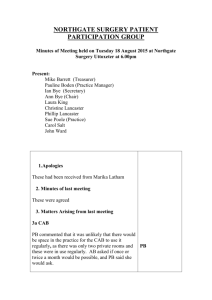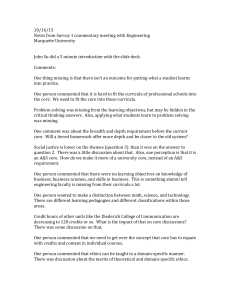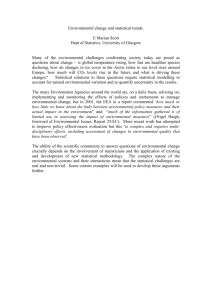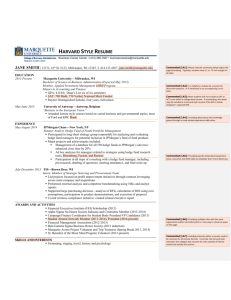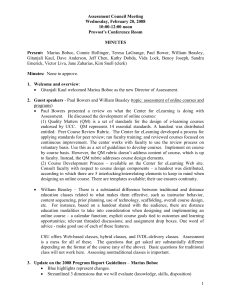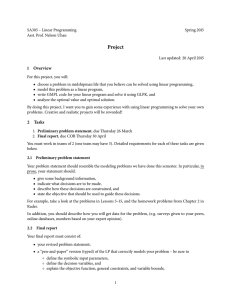Assessment Council Meeting Monday, April 21, 2008 1:00-3:00 pm Provost’s Conference Room
advertisement
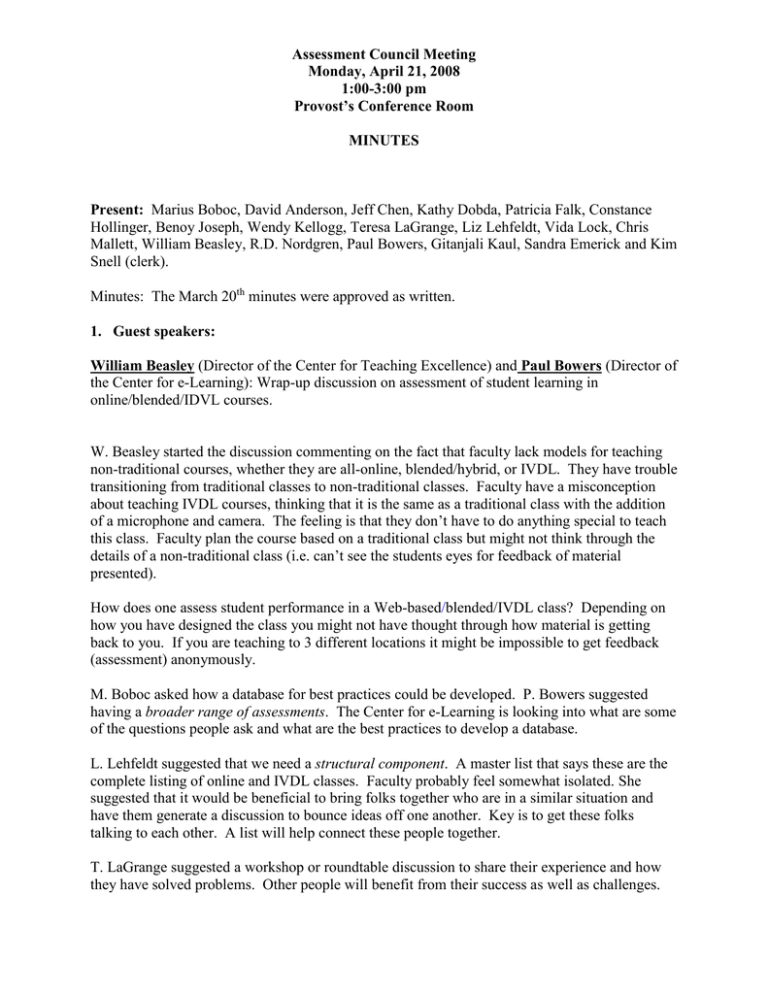
Assessment Council Meeting Monday, April 21, 2008 1:00-3:00 pm Provost’s Conference Room MINUTES Present: Marius Boboc, David Anderson, Jeff Chen, Kathy Dobda, Patricia Falk, Constance Hollinger, Benoy Joseph, Wendy Kellogg, Teresa LaGrange, Liz Lehfeldt, Vida Lock, Chris Mallett, William Beasley, R.D. Nordgren, Paul Bowers, Gitanjali Kaul, Sandra Emerick and Kim Snell (clerk). Minutes: The March 20th minutes were approved as written. 1. Guest speakers: William Beasley (Director of the Center for Teaching Excellence) and Paul Bowers (Director of the Center for e-Learning): Wrap-up discussion on assessment of student learning in online/blended/IDVL courses. W. Beasley started the discussion commenting on the fact that faculty lack models for teaching non-traditional courses, whether they are all-online, blended/hybrid, or IVDL. They have trouble transitioning from traditional classes to non-traditional classes. Faculty have a misconception about teaching IVDL courses, thinking that it is the same as a traditional class with the addition of a microphone and camera. The feeling is that they don’t have to do anything special to teach this class. Faculty plan the course based on a traditional class but might not think through the details of a non-traditional class (i.e. can’t see the students eyes for feedback of material presented). How does one assess student performance in a Web-based/blended/IVDL class? Depending on how you have designed the class you might not have thought through how material is getting back to you. If you are teaching to 3 different locations it might be impossible to get feedback (assessment) anonymously. M. Boboc asked how a database for best practices could be developed. P. Bowers suggested having a broader range of assessments. The Center for e-Learning is looking into what are some of the questions people ask and what are the best practices to develop a database. L. Lehfeldt suggested that we need a structural component. A master list that says these are the complete listing of online and IVDL classes. Faculty probably feel somewhat isolated. She suggested that it would be beneficial to bring folks together who are in a similar situation and have them generate a discussion to bounce ideas off one another. Key is to get these folks talking to each other. A list will help connect these people together. T. LaGrange suggested a workshop or roundtable discussion to share their experience and how they have solved problems. Other people will benefit from their success as well as challenges. K. Dobda asked if there are there websites out there that have a list of best practices for online courses. Please include the library if a workshop is scheduled. Kathy would like to be involved if a workshop is scheduled. M. Boboc asked for suggestions for Fall semester. He mentioned offering joint mini-grants that focus on online courses. J. Chen – IR has offered a list online for instructors. W. Beasley commented that IVDL does not have a home on this campus and nobody is responsible for what is done other than handing out equipment. Very unsuccessful in getting faculty to come to a workshop because they think they can teach this without help. He does not have a quick and easy solution to the problem. C. Hollinger commented that sometimes it is easier to learn through experience. Faculty can share the pitfalls they have encountered and how they have overcome them. T. LaGrange added that it will be difficult to get faculty involved in a workshop for IVDL. P. Bowers offered to collaborate with W. Beasley’s office to address these situations. He suggested providing incentives for those who are teaching IDVL to attend a workshop. This would be a way to recognize the value of their time. One focus would be to work with programs who offer many IVDL classes instead of individual instructors. M. Boboc commented that the 3 of us might be able to join forces and combine a workshop. V. Lock suggested sending out a survey via Survey Monkey. It would be helpful to find out if faculty would be interested in doing something like this. It would also be a way of making them aware of the different areas that would be covered. W. Kellogg – Question about current student evaluations to be used for online courses? P. Bowers – They are supposed to go live on Wednesday. System like this would allow you to add questions that would only be viewed by whoever is responsible for that piece. Faculty can view the student evaluations. What questions would we like to ask students? 2. Update(s): North Central Association – Higher Learning Commission Conference – Chicago, April 11-15 (Liz Lehfeldt – General Education; R.D. Nordgren – Self-study; Marius – Assessment) L. Lehfeldt commented that she mainly went to sessions on Gen Ed. She felt that she did not learn a lot of new stuff from the previous conference. However, she wanted to plant 3 possible seeds about Gen Ed and CSU. 1. Might want to consider constituting a Gen Ed committee on assessment. 2. Generate faculty buy-in. She suggested providing some sort of faculty incentive to get faculty in the game. 3. Tie in the notion of Gen Ed assessment with faculty development. R.D. Nordgren commented that he focused on the self-study sessions. The main point that he took away from the conference is collegiality. He commented that there was lots of support from everyone. He attended presentations on the whole process. Examples of conference presentations included one from Northeast Oklahoma State entitled I just learned that I am the coordinator. Now what? University of Illinois at Springfield had a presentation entitled How to eat an elephant or how to get through the process one bite at a time. He felt that the Commission provides excellent direction. PEAK is also willing to help. They will come in September to kick off the self-study process. M. Boboc responded that there is a definite link between accreditation and assessment. He agreed with R.D. that people were very helpful and supportive. The presentations involved different levels of involvement. They were geared from the beginner to the highly experienced. He also agreed that faculty buy-in is crucial. He attended a session entitled How to transform our assessment culture from a foe to a friend. He also commented that he learned that accreditation is a very complex process. It will require help from all levels. Software is available to help with the process. He mentioned the possibility of using LiveText software. He will be meeting with R.D. and Gitanjali to discuss the details. W. Kellogg asked if the University can provide a map of how community engagement, engaged learning, assessment and accreditation fit together. She wondered how the data will be used. Can all the committees collaborate and figure out how to minimize the data collection. R.D. responded that they will work to minimize the data collection. There are good models from other Universities to look at. C. Mallett commented that at the department level people wonder WHY are we doing this. Generally speaking how are we doing in terms of our sister universities? R.D. responded that Youngstown just completed their self-study and it was very good. M. Boboc responded that CSU is comparable in terms of Gen Ed assessments, ect. We are part of the critical mass with success stories. C. Hollinger commented that 10 years ago the NCA were happy campers except for Assessment. At the fifth year mark they were pretty happy. K. Dobda commented that a new website will be unveiled in the summer with an intranet and internet. Some data should be made available. J. Chen commented that the NCA first looks at the data that has been collected and how it is used in the decision making process. He suggested that holding workshops for non-traditional classes will show the NCA what we are doing and how we are using the data. B. Joseph commented that if the process is overly complicated then it loses its intent. Simplicity might be a good criterion to use. The goal should be to have good learning and assessment should be secondary. R.D. Nordgren commented that a Steering Committee will be formed and then several subcommittees to start off the self-study process. Office of Student Learning Assessment (OSLA) Web site (Marius) M. Boboc had the web site up for all to view. He went through several changes that he has made including changing the welcome message on the home page. M. Boboc asked for suggestions for any additional changes that should be made. T. LaGrange commented that the web site should be located in the A-Z index. It is very difficult to find otherwise. He also changed the navigational menu. He introduced the new acronym – OSLA (Office of Student Learning Assessment). The other pages that were changed include: Assessment Overview – Focus on the fact that assessment involves the whole campus community. Policies and Procedures – Guidelines for 2008 Assessment Reports are available online; they can also be downloaded from our Assessment Web site. Responsibilities – List of individuals may change in the future. Summer Assessment Review Days – Right now we have pictures of those involved in the Assessment Review sessions last year; listing of individuals to be added, too. New – Websites and Related Links (under Assessment Resources) – will continue to expand Calendar and Events – Reports Due Date, Summer Review Days; once we are done with the assessment report reviews this summer, we are going to post new dates and announcements related to future assessment-related events in the new academic year (2008-2009). D. Anderson asked if it is acceptable for the public to view the reports on-line. T. LaGrange responded that there should be a separating of documents from intranet to extranet. She felt that individual reports should not be viewed publicly. B. Joseph commented that when a report is posted on a public access venue, departments might not be so candid about exposing areas of weakness, ect. D. Anderson cautioned that we should think about posting reports for everyone in the university to access. V. Lock suggested that they should be behind a password sign-in wall. P. Falk suggested that reports should be used as a sample. Only a couple should be available. B. Joseph commented that these are working documents for us to do a better job at what we are doing. Posting reports will change the dynamics and candor of what is reported. There are two different issues – (1) Should it be available for public disclosure? (2) Should it be available via an intranet? M. Boboc asked how we collect “good” reports as samples. T. LaGrange suggested asking departments permission to use their “good” report. V. Lock responded that the report can be changed to be a generic example (change department names, people names, ect.) J. Chen cautioned that the NCA will want to know who has access to these reports. If faculty does not have access to a report by the Dean then it could reflect on us negatively. M. Boboc suggested that samples can be made public and reports under sign-in. Assessment Review Days (Marius) M. Boboc reported that he has received messages from 33 people who are interested in participating in Assessment Review Days. Highest number last year was 41 reviewers. 3. Future Business (brainstorm for ideas): Updates from different colleges/programs/units on student learning assessment endeavors (current and future) T. LaGrange commented that the Advising Offices have initiated a process for student services surveys. (Re)Capturing Assessment Momentum – how to make the assessment culture on our campus “transformative and participative? M. Boboc asked for suggestion on what else might we tackle next year to help us gain momentum. K. Dobda commented that it is time for workshops with outside speakers. There have been some excellent speakers in the past, such as Doug Eder. Peter Hernon writes a lot on student learning outcomes (library focused). M. Boboc suggested workshops with people who are successful with Assessments. C. Hollinger suggested showcasing activities that we are already involved in. V. Lock responded that there must be some way to turn the thinking of faculty around regarding assessment. C. Hollinger commented that when you see the effects of the process it helps to engage faculty. M. Boboc agreed that people buy-in more by seeing the positive effects. T. LaGrange suggested getting people who have been successful in revealing something through the assessment process and who have made positive changes would be inspirational. We should work with programs that are acting on the findings of the reports. M. Boboc suggested involving faculty in presenting at workshops. He also suggested reducing teaching load for faculty involved in assessment with the possibility of becoming a consultant to struggling programs. K. Dobda felt that we should have involvement year-round. “Standards of Quality” Best Practices. Examples from other entities. The main focus would be on what represents indicators of quality by which programs and units on campus compare themselves to established criteria. Identifying student learning assessment-related needs M. Boboc asked for continued input on what different programs and units on campus might need related to assessment of student learning – meetings with individual faculty and staff, workshops, print materials, etc. Mission statement for the OSLA? M. Boboc commented that we need to refine what this office is about by expanding the mission statement and linking it to the University mission. Also, there should be alignment to the policies and procedures used in collecting and reviewing assessment reports. Quality control for OSLA? M. Boboc commented that there should be standards in place for this office. B. Joseph asked how we can assess leadership. We want to incorporate these into our goals. Can we go into your website to see these things? M. Boboc responded that the resources page will eventually have this information. Thank you for a fruitful semester! See you again in the Fall – details about dates and times will be circulated later.
